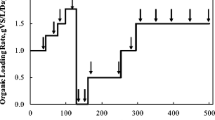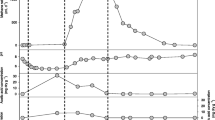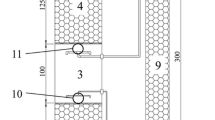Abstract
The prokaryotic diversity associated with organic household waste (OHW), leachate (start-up inoculum), and mesophilic anaerobic digestion processes in the degradation of OHW for 44 and 90 days was investigated using a culture-independent approach. Bacterial and archaeal 16S rRNA and mcrA gene clone libraries were constructed from community DNA preparations. Bacterial clones were affiliated with 13 phyla, of which Firmicutes, Proteobacteria, and Bacteroidetes were represented in all libraries, whereas Actinobacteria, Thermotogae, Lentisphaerae, Acidobacteria, Chloroflexi, Cyanobacteria, Synergistetes, Spirochaetes, Deferribacteres, and Deinococcus-Thermus were exclusively identified in a single library. Within the Archaea domain, the Euryarchaeota phylum was the only one represented. Corresponding sequences were associated with the following orders of hydrogenotrophic methanogens: Methanomicrobiales (Methanoculleus genus) and Methanobacteriales (Methanosphaera and Methanobacterium genera). One archaeal clone was not affiliated with any order and may represent a novel taxon. Diversity indices showed greater diversity of Bacteria when compared to methanogenic Archaea.









Similar content being viewed by others
References
Abegglen C, Ospelt M, Siegrist H (2008) Biological nutrient removal in a small-scale MBR treating household wastewater. Water Res 42:338–346
Angenent LT, Sung S, Raskin L (2002) Methanogenic population dynamics during startup of a full-scale anaerobic sequencing batch reactor treating swine waste. Water Res 36:4648–4654
Ausubel F, Brent R, Kingston R, Moore D, Seidman J, Smith H, Strujil K (eds) (1990) Current Protocols in Molecular Biology, vol 1. Greene Publishing Associates and Wiley–Interscience, New York
Banning N, Brock F, Fry JC, Parkes RJ, Hornibrook ER, Weightman AJ (2005) Investigation of the methanogen population structure and activity in a brackish lake sediment. Environ Microbiol 7:947–960
Bond PL, Hugenholtz P, Keller J, Blackall LL (1995) Bacterial community structures of phosphate-removing and non-phosphate-removing activated sludges from sequencing batch reactors. Appl Environ Microbiol 61:1910–1916
Boone DR, Whitman WB, Koga Y (2001) Methanomicrobiales. In: Boone DR, Castenholz RW (eds) Bergeys manual of systematic bacteriology, vol1. The archaea and the deeply and phototrophic bacteria, 2nd edn. Springer, New York, pp 246–267
Chao A (1984) Non-parametric estimation of the number of classes in a population. Scand J Stat 11:265–270
Delong EF (1992) Archaea in coastal marine environments. Proc Natl Acad Sci 89:5685–5689
Fernández N, Díaz EE, Amils R, Sanz JL (2008) Analysis of microbial community during biofilm development in an anaerobic wastewater treatment reactor. Microb Ecol 56:121–132
Figuerola ELM, Erijman E (2007) Bacterial taxa abundance pattern in an industrial wastewater treatment system determinated by the full rRNA cycle approach. Environ Microbiol 7:1780–1789
Filya I (2003) The effect of Lactobacillus buchneri and Lactobacillus plantarum on the fermentation, aerobic stability, and ruminal degradability of low dry matter corn and sorghum silages. J Dairy Sci 86:3575–3581
Good IJ (1953) The population frequencies of species and the estimation of population parameters. Biometrika 40:237–262
Hattori S, Luo H, Shoun H, Kamagata Y (2001) Involvement of formate as an interspecies electron carrier in a syntrophic acetate oxidizing anaerobic microorganism in coculture with methanogens. J Biosci Bioeng 91:294–298
Hughes JB, Bohannan BJM (2004) Application of ecological diversity statistics in microbial ecology. In: Kowalchuk GA, de Bruijn FJ, Head IM, Akkermans AD, van Elsas JD (eds) Molecular microbial ecology manual, 2nd edn. Kluwer Academic, London, pp 1321–1344
Henriksen JR (2004) webLIBSHUFF (http://libshuff.mib.uga.edu)
Karakashev D, Batstone DJ, Angelidaki I (2005) Influence of environmental conditions on methanogenic compositions in anaerobic biogas reactors. Appl Environ Microbiol 71:331–338
Kersters K, De Vos P, Gillis M, Swings J, Vandamme P, Stackebrandt E (2003) Introduction to the Proteobacteria. In Dworkin M et al. (eds) The prokaryotes: an evolving electronic resource for the microbiological community, 3rd ed., release 3.12, 28 March 2003 Online Springer, New York, N.Y. http://link.springer-ny.com/service/books/10125
Krause L, Diaza NN, Edwardse RA, Gartemanna KH, Krömekea H, Neuwegera H, Pühlerd A, Runte KJ, Schlüterd A, Stoyea J, Szczepanowski R, Taucha A, Goesmanna A (2008) Taxonomic composition and gene content of a methane-producing microbial community isolated from a biogas reactor. J Biotechnol 136:91–101
Kumar S, Tamura K, Nei M (2004) MEGA3: integrated software for molecular evolutionary genetics analysis and sequence alignment. Brief Bioinform 5:150–163
Lalman JA, Bagley DM (2001) Anaerobic degradation and methanogenic effects of oleic and stearic acids. Water Res 35:2975–2983
Lastella G, Testa C, Cornacchia G, Notornicola M, Voltasio F, Sharma VK (2002) Anaerobic digestion of semi-solid organic waste: biogas production and its purification. Energy Convers Manag 43:63–75
Lane DJ (1991) 16S/23S rDNA sequencing. In: Stackebrandt E, Goodfellow M (eds) Nucleic acid techniques in bacterial systematics. Wiley, New York, pp 115–148
Leclerc M, Delgenes JP, Godon JJ (2004) Diversity of the archaeal community in 44 anaerobic digesters as determined by single strand conformation polymorphism analysis and 16S rDNA sequencing. Environ Microbiol 6:809–819
Levén L, Anders R, Ericksson B, Schurer A (2007) Effect of process temperature on bacterial and archaeal communities in two methanogenic bioreactors treating organic household waste. FEMS Microbiol Ecol 59:683–693
Lozada M, Itria RF, Figuerola ELM, Babay PA, Gettar RT, de Túlio LA, Erijman L (2004) Bacterial community shifts in nonylphenoll polyethoxylates-enriched activated sludge. Water Res 38:2077–2086
Lovley DR (1991) Dissimilatory Fe(III) and Mn(IV) reduction. Microbiol Mol Biol Rev 55:259–287
Luton PE, Wayne JM, Sharp RJ, Riley PW (2002) The mcrA gene as an alternative to 16S rRNA in the phylogenetic analyses of methanogen populations in landfill. Microbiology 148:3521–3530
Maidak BL, Cole JR, Lilburn TG, Parker CT Jr, Saxman PR, Farris RJ (2001) The RDP-II (Ribosomal database project). Nucleic Acids Res 29:173–174
Montero B, Garcia-Morales JL, Sales D, Solera R (2007) Evolution of microorganisms in thermophilic-dry anaerobic digestion. Bioresour Technol 99:3233–3243
Moyer GL, Dobbs FC, Karl DM (1994) Estimation of diversity and community structure through restriction fragment length polymorphism distribution analysis of bacterial 16S rRNA genes from a microbial mat at an active, hydrothermal vent system, Loihi Seamount, Hawaiit. Appl Environ Microbiol 60:871–879
Pettitt AN (1982) Cramer-von Mises statistic. In: Kotz S, Johnson NL (eds) Encyclopedia of statistical sciences. Wiley-Interscience, New York, pp 220–221
Rastogi G, Ranade DR, Yeole TY, Patole MS, Shouche YS (2008) Investigation of methanogen population structure in biogas reactor by molecular characterization of methyl-coenzyme M reductase A (mcrA) genes. Bioresour Technol 99:5317–5326
Saitou N, Nei M (1987) The neighbor-joining method: a new method for reconstructing phylogenetic trees. Mol Biol Evol 4:406–425
Sasaki K, Haruta S, Ueno Y, Ishii M, Igarashi Y (2006) Archaeal population on supporting material in a methanogenic packed-bed reactor. J Biosci Bioeng 102:244–246
Sasaki K, Haruta S, Ueno Y, Ishii M, Igarashi Y (2007) Microbial population in the biomass adhering to supporting material in a packed-bed reactor degrading organic solid waste. Appl Microbiol Biotechnol 75:941–952
Schloss PD, Handelsman J (2005) Introducing DOTUR, a computer program for defining operational taxonomic units and estimating species richness. Appl Environ Microbiol 71:1501–1506
Schloss PD, Larget BR, Handelsman J (2004) Integration of microbial ecology and statistics: a test to compare gene libraries. Appl Environ Microbiol 70:5485–5192
Schnuërer A, Schink B, Svensson BH (1996) Clostridium ultunense sp. nov., a mesophilic bacterium oxidizing acetate in syntrophic association with a hydrogenotrophic methanogenic bacterium. Int J Syst Bacteriol 46:1145–1152
Schnurer A, Zellner G, Svensson BH (1999) Mesophilic syntrophic acetate oxidation during methane formation in biogas reactors. FEMS Microbiol Ecol 29:249–261
Singleton DR, Furlong MA, Rathbun SL, Whitman WB (2001) Quantitative comparisons of 16S rDNA sequence libraries from environmental samples. Appl Environ Microbiol 67:4373–4376
Slobodkin AI (2005) Thermophilic microbial metal reduction. Microbiology 74:5501–5514
Speece RE (1983) Anaerobic biotechnology for industrial wastewater-treatment. Environ Sci Technol 17:416–427
Stackebrandt E, Goebel BM (1994) Taxonomic note: a place for DNA: DNA reassociation and 16S rRNA sequence analysis in the present species definition in bacteriology. Int J System Bacteriol 44:846–849
Suzuki M, Rappe MS, Giovannoni S (1998) Kinetic bias in estimates of coastal picoplankton community structure obtained by measurements of small-subunit rRNA gene PCR amplicon length heterogenity. Appl Environ Microbiol 64:4522-4529
Talbot G, Topp E, Palin MF, Massé DI (2007) Evaluation of molecular methods used for establishing the interactions and functions of microorganisms in anaerobic bioreactors. Water Res 3:513–537
Tang Y, Shigematsu T, Ikbal Morimura S, Kida K (2004) The effects of micro-aeration on the phylogenetic diversity of microorganisms in a thermophilic anaerobic municipal solid-waste digester. Water Res 38:2537–2550
Xian Qu Mazéas L, Vavilin VA, Epissard J, Lemunier M, Mouchel JM, Pin-jing He, Bouchez T (2009) Combined monitoring of changes in δ13CH4 and archaeal community structure during mesophilic methanization of municipal solid waste. FEMS Microbiol Ecol 68:236–245
Yadvika SH, Sreekrishnan TR, Kohli S, Rana V (2004) Enhancement of biogas production from solid substrates using different techniques—a review. Bioresource Technol 95:1–10
Weiss A, Jérôme V, Freitag R, Mayer HK (2008) Diversity of the resident microbiota in a thermophilic municipal biogas plant. Appl Microbiol Biotechnol 81:163–173
Wiegel J, Tanner R, Rainey FA (2005) An introduction to the family Clostridiaceae. In: Dworkin M (ed) The prokaryotes: an evolving electronic resource for the microbiological community, 3rd edn. Springer, New York
Acknowledgments
We appreciate the financial support provided by Fundação de Amparo à Pesquisa do Estado de Minas Gerais (FAPEMIG), Conselho Nacional de Desenvolvimento Científico e Tecnológico (CNPq), and Coordenação de Aperfeiçoamento de Pessoal de Nível Superior (CAPES) in the form of a scholarship to Juliana Cardinali Rezende. We are grateful to Defesa Florestal Limitada (DEFLOR/LTDA) for their technical support.
Author information
Authors and Affiliations
Corresponding author
Electronic supplementary material
Below is the link to the electronic supplementary material.
Supplementary Table S1
(DOC 142 kb)
Supplementary Table S2
(DOC 71 kb)
Supplementary Table S5
(DOC 28 kb)
Supplementary Fig. 3A
Rarefaction curves of (A) archaeal and bacterial 16S rRNA genes in LC, OHW, OT44, and OT90 libraries and (B) archaeal mcrA gene in LC, OHW, and OT44 libraries. Clones were grouped into OTUs at a level of sequence similarity of ≥97%. A and B denote bacterial and archaeal clones, respectively. (GIFF 106 kb)
Supplementary Fig. 3B
Rarefaction curves of (A) archaeal and bacterial 16S rRNA genes in LC, OHW, OT44 and OT90 libraries and (B) archaeal mcrA gene in LC, OHW, and OT44 libraries. Clones were grouped into OTUs at a level of sequence similarity of ≥97%. A and B denote bacterial and archaeal clones, respectively. (GIFF 93 kb)
Supplementary Fig. 4A
Results of LIBSHUFF comparisons of bacterial clone libraries from LC and OHW samples. Homologous and heterologous coverage curves for bacterial 16S rRNA gene sequences are presented. (A) OHW as homologous coverage and LC as heterologous coverage; (B) LC as homologous coverage and OHW as heterologous coverage. Taxonomic distances (D) were calculated using the Jukes–Cantor correction. (GIFF 60 kb)
Supplementary Fig. 4B
Results of LIBSHUFF comparisons of bacterial clone libraries from LC and OHW samples. Homologous and heterologous coverage curves for bacterial 16S rRNA gene sequences are presented. (A) OHW as homologous coverage and LC as heterologous coverage; (B) LC as homologous coverage and OHW as heterologous coverage. Taxonomic distances (D) were calculated using the Jukes–Cantor correction. (GIFF 55 kb)
Rights and permissions
About this article
Cite this article
Cardinali-Rezende, J., Debarry, R.B., Colturato, L.F.D.B. et al. Molecular identification and dynamics of microbial communities in reactor treating organic household waste. Appl Microbiol Biotechnol 84, 777–789 (2009). https://doi.org/10.1007/s00253-009-2071-z
Received:
Revised:
Accepted:
Published:
Issue Date:
DOI: https://doi.org/10.1007/s00253-009-2071-z




